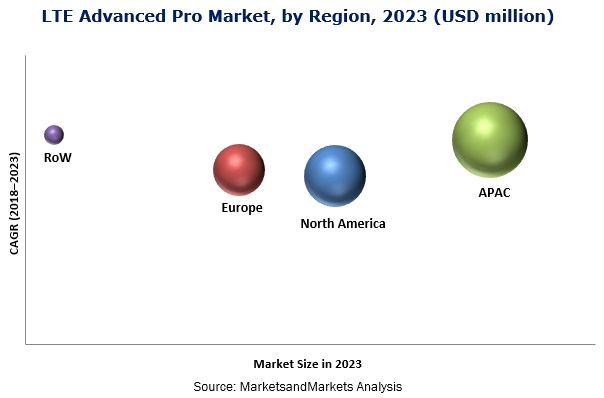Practices › Communication & Connectivity Technology › LTE Advanced Pro Market
LTE Advanced Pro Market
The overall LTE Advanced Pro market is estimated to be valued at USD 150.0 million in 2018 and is expected to reach USD 8,017.5 million by 2023, at a CAGR of 121.6% from 2018 to 2023. Major drivers for this market are as follows: LTE Advanced Pro delivering higher bitrates in a cost-efficient manner; improved efficiency with additional functionality; reduced latency and optimized connectivity; and growing demand for improved network coverage.
The LTE Advanced Pro market has been segmented on the basis of communication infrastructure, core network technology, and deployment location. In terms of communication infrastructure, small cell is expected to hold the largest share of the market by 2023. The increasing number of buildings in cities has led to obstruction in telecom signals and is leading to poor quality of services and degraded customer experience. It is estimated that a large volume of data will be transferred between devices. To handle such large volumes of data at high speed, reliable network connectivity is imperative, and small-cell antenna systems will play an integral role in carrying out the communication process efficiently.
By core network technology, the LTE Advanced Pro market for NFV is expected to grow at the highest CAGR during the forecast period. For network operators to handle such huge data, increasing network capacity is a major challenge. NFV can play a critical role in overcoming this challenge. NFV promises to ease the load by granting service providers the flexibility to move network functions from dedicated appliances to generic servers.
Of all the major deployment locations, urban areas held the largest share of the LTE Advanced Pro market in 2017. Need for enhanced network capacity and coverage in locations such as city center zones, subways, and stadiums, which are always populated with a large number of occupants, is a major driver for the growth of the market in urban areas.
The LTE Advanced Pro market for the retail stores deployment is expected to grow at the highest CAGR between 2018 and 2023. Retail malls often face limited data coverage issue. High demand for accurate data and information flow at high speed in retail automation will drive the growth of the LTE Advanced pro network in retail stores.

Of all the regions, North America held the largest size of the global LTE Advanced Pro market in 2017. North America has emerged as a prominent region in terms of the adoption and implementation of LTE Advanced Pro services and applications. It is anticipated to witness strong demand for wireless cellular network across urban areas, residential areas, and rural areas, among others. The market in RoW is expected to grow at the highest CAGR between 2018 and 2023 followed by APAC. The growth of the market in APAC is attributed to THE adoption of new technologies and advancements by organizations functioning across various sectors. The region has become the center of attraction for major investments and business expansion opportunities.
key restraining factors for the global LTE Advanced Pro market are limitations on waveform flexibility and synchronization robustness. The underlying concern of the industry regarding shortening timescales for Phase I (rel. 15) may lead to technical ambiguity in air interface technologies and further compromise 5G quality.
Key players in the LTE Advanced Pro market are Huawei (China), Nokia Networks (Finland), Ericsson (Sweden), Samsung Electronics (South Korea), ZTE (China), NEC (Japan), Cisco Systems (US), Qualcomm (US), and Intel (US).
Leading LTE Advanced Pro network vendors are developing solutions for existing and new deployment opportunities to enhance better connectivity and high data speeds.
Residential Areas
Many devices and components (such as smart sensors, lighting systems, and alarm systems) are connected to each other over a network to accomplish tasks such as smoke monitoring, temperature control, and HVAC system control. To operate these systems remotely, an operator needs a quick real-time response, with low latency. Cellular network features high response time, high data transfer rate, and reliable connectivity, which make it a better network option for residential buildings and infrastructure applications than other networks.
Public Spaces
In public spaces, LTE Advanced Pro is mainly deployed in parks, plazas, large sports stadiums, entertainment arenas, and exhibition venues. Small cells and DAS are increasingly being selected as systems of choice by public space owners and neutral host providers to offer maximum wireless connectivity reach. Public venues are also keen on taking advantage of 4G LTE services, as these not only enhance service experience but also offer a competitive edge to building owners.
Rural Areas
Rural areas deployment includes remote towns and terrains, maritime, and remote industrial (mines and oil rigs). Rural areas offer huge growth opportunities to carriers willing to surge their subscriber base and coverage. The introduction of cellular communication in industrial areas would provide an additional alternative to manufacturers for wireless communication. Moreover, cellular communication has built-in security, and users can put up virtual private network (VPN) tunnels between remote devices and a central site for transmitting and receiving data
Critical Questions
- Will LTE be overshadowed by 5G or act as backward compatibility?
- What are probable hot bets for network vendors considering wireless tech as future connectivity tech?
- What are the adjacent markets that companies can leverage or explore?
- Is there any threat/opportunity from new regulations/entrants to existing ecosystem telecom operators and network vendors?
